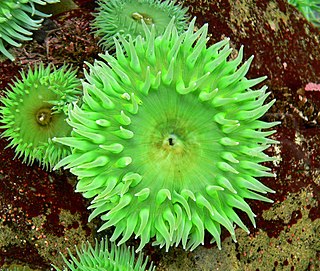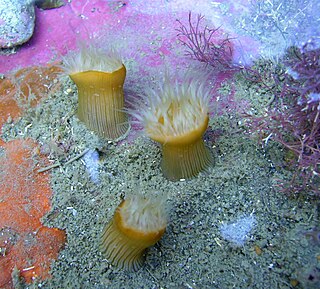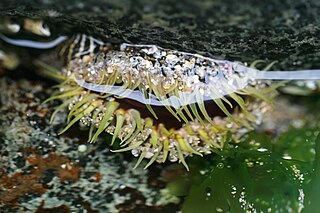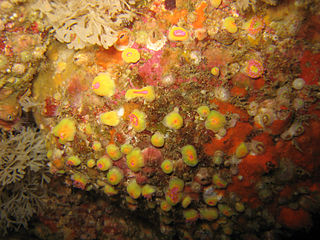
Anthozoa is a class of marine invertebrates which includes the sea anemones, stony corals and soft corals. Adult anthozoans are almost all attached to the seabed, while their larvae can disperse as part of the plankton. The basic unit of the adult is the polyp; this consists of a cylindrical column topped by a disc with a central mouth surrounded by tentacles. Sea anemones are mostly solitary, but the majority of corals are colonial, being formed by the budding of new polyps from an original, founding individual. Colonies are strengthened by calcium carbonate and other materials and take various massive, plate-like, bushy or leafy forms.

The aggregating anemone, or clonal anemone, is the most abundant species of sea anemone found on rocky, tide swept shores along the Pacific coast of North America. This cnidarian hosts endosymbiotic algae called zooxanthellae that contribute substantially to primary productivity in the intertidal zone. The aggregating anemone has become a model organism for the study of temperate cnidarian-algal symbioses.

The starlet sea anemone is a species of small sea anemone in the family Edwardsiidae native to the east coast of the United States, with introduced populations along the coast of southeast England and the west coast of the United States. Populations have also been located in Nova Scotia, Canada. This sea anemone is found in the shallow brackish water of coastal lagoons and salt marshes where its slender column is usually buried in the mud and its tentacles exposed. Its genome has been sequenced and it is cultivated in the laboratory as a model organism, but the IUCN has listed it as being a "Vulnerable species" in the wild.

The Davenport Tide Pools are located just past the town of Davenport, California in the United States. They are located off Davenport Landing, which is a street off Highway 1. The tide pools are unique due to the ridges that run up and down the tide pools, allowing for different organisms to live close, even though in a normal habitat they would be unable to do so. The Beach is open sunrise to sunset, and is day use only.

The starburst anemone or sunburst anemone is a species of sea anemone in the family Actiniidae. The sunburst anemone was formerly considered the solitary form of the common aggregating anemone, but was identified as a separate species in 2000.

Urticina crassicornis, commonly known as the mottled anemone, the painted anemone or the Christmas anemone, is a large and common intertidal and subtidal sea anemone. Its habitat includes a large portion of the coastal areas of the northern hemisphere, mainly polar regions, and it lives a solitary life for up to 80 years. Mottled anemones are similar to Dahlia anemones and both are commonly referred to as northern red anemones.

Sea anemones are a group of predatory marine animals of the order Actiniaria. Because of their colourful appearance, they are named after the anemone, a terrestrial flowering plant. Sea anemones are classified in the phylum Cnidaria, class Anthozoa, subclass Hexacorallia. As cnidarians, sea anemones are related to corals, jellyfish, tube-dwelling anemones, and Hydra. Unlike jellyfish, sea anemones do not have a medusa stage in their life cycle.

Condylactis gigantea is a tropical species of ball anemone that is found in shallow reefs and other shallow inshore areas in the Caribbean Sea – more specifically the West Indies – and the western Atlantic Ocean including southern Florida through the Florida Keys. It is also commonly known as: giant Caribbean sea anemone, giant golden anemone, condylactis anemone, Haitian anemone, pink-tipped anemone, purple-tipped anemone, and Florida condy. This species can easily be seen growing in lagoons or in inner reefs as either individuals or loose groups, but never as colonies. They are often used as a model organism along with others in their genus for facultative symbiosis with monocellular algae.

Anthopleura xanthogrammica, or the giant green anemone, is a species of intertidal sea anemone of the family Actiniidae.

Anthopleura michaelseni, commonly known as the long-tentacled anemone or crevice anemone, is a species of sea anemone in the family Actiniidae. It is native to very shallow water round the coasts of southern Africa between Lüderitz and Durban.

Epiactis prolifera, the brooding, proliferating or small green anemone, is a species of marine invertebrate in the family Actiniidae. It is found in the north-eastern Pacific. It has a feature rare among animals in that all individuals start life as females but develop testes later in their lives to become hermaphrodites.
Actinia bermudensis, the red, maroon or stinging anemone, is a species of sea anemone in the family Actiniidae.
Cerianthus lloydii is a species of tube-dwelling sea anemone in the family Cerianthidae. It is sometimes called the lesser cylinder anemone and is found in shallow seas around the coasts of north west Europe.

Bartholomea annulata is a species of sea anemone in the family Aiptasiidae, commonly known as the ringed anemone or corkscrew anemone. It is one of the most common anemones found on reefs in the Caribbean Sea.

Anthothoe albocincta, or white-striped anemone, is a species of sea anemone in the family Sagartiidae. It is native to the coasts of Australia and New Zealand.

Oulactis muscosa, also known as the sand anemone and speckled anemone, is a species of sea anemone in the family Actiniidae.

Anthopleura ballii, commonly known as the red speckled anemone, is a species of sea anemone in the family Actiniidae. It is found in shallow water in the northeastern Atlantic Ocean.
Anthopleura thallia, commonly known as the glaucous pimplet, is a species of sea anemone in the family Actiniidae. It is found in shallow water in the northeastern Atlantic Ocean and the Mediterranean Sea.

Corynactis viridis, the jewel anemone, is a brightly coloured anthozoan similar in body form to a sea anemone or a scleractinian coral polyp, but in the order Corallimorpharia. It is found in the northeastern Atlantic Ocean and the Mediterranean Sea and was first described by the Irish naturalist George Allman in 1846.

Bunodosoma californicum is a species of sea anemone. Is was first described to science by Oskar Carlgren in 1951. The type specimen that Carlgren used to describe the species was collected by Ed Ricketts in Puerto Escondido during his trip to the Gulf of California with John Steinbeck recounted in The Log From the Sea of Cortez.


















